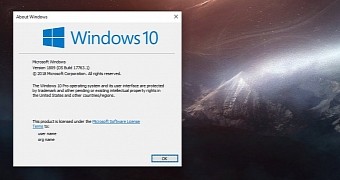As I said earlier today, new statistics indicate that Windows 10 version 1809, also known as the October 2018 Update, is becoming Microsoft’s least successful OS update so far, with adoption numbers well behind those of its predecessors.
AdDuplex data shows that only 21.2% of the Windows 10 devices out there are currently running the October update, while the April 2018 Update, which was launched nearly one year ago, continues to be number one with 71.6% share.
But let’s take everything one at a time and see how we ended up with a Windows 10 version that nobody wants to install.
Back on October 2, Microsoft started the public rollout of Windows 10 October 2018 Update, making it available for the first wave of devices and for users who wanted to trigger the upgrade manually.
Only a few days later, the software giant decided to pull the update because of an issue that caused the removal of user files stored in libraries. As it was discovered shortly after that, the bug was actually spotted while the update was still in testing, only that Microsoft ignored the reports sent by insiders.
Fast-forward to November and here’s Microsoft re-releasing the October update, this time embracing a more cautious approach to make sure that no other major issues were encountered.
And yet, this didn’t mean the new Windows 10 feature update was flawless. In fact, Microsoft itself blocked the upgrade for several devices due to software or hardware compatibility issues, clearly in an attempt to avoid repeating the previous mistakes.
However, the rollout advanced at a painfully slow pace, and on January 16, Microsoft announced that it was starting the phased release to users via Windows Update.
“We are now starting our phased rollout to users via Windows Update, initially offering the update to devices we believe will have the best update experience based on our next generation machine learning model,” the company said.
The update also became available for users who manually checked for updates the same day.
This means Microsoft only started the gradual rollout and released the update as a manual download more than three months after the original launch. With two major updates shipped every six months, this is where things are getting more complicated.
There are lots of devices out there that haven’t even received the October update, and with another feature update just around the corner, the biggest question is whether it still make any sense to install version 1809.
As per Microsoft’s normal schedule, the next update should be finalized in March, while the rollout in waves to devices across the world should begin in April. This means the company still has some two months to push the October update to as many devices as possible and thus pave the way for the next update.
However, there’s a good chance this isn’t going to happen, and that 21.2% share is living proof there’s only a slight chance the October update can become number one on such short notice.
Does it still make any sense to install the October update at this point? This is a question that Microsoft itself must answer, especially because version 1809 became the buggiest Windows 10 update ever due to the company’s very own mistakes (such as skipping the Release Preview ring and beginning the public rollout directly).
As things are right now, many users might just hold back the upgrade until the April 2019 update goes live, which means they eventually end up installing one major feature update every 12 months.
Which takes us to another rhetorical question: should Microsoft stick with this two-feature-updates-every-year schedule for Windows 10?

 14 DAY TRIAL //
14 DAY TRIAL //